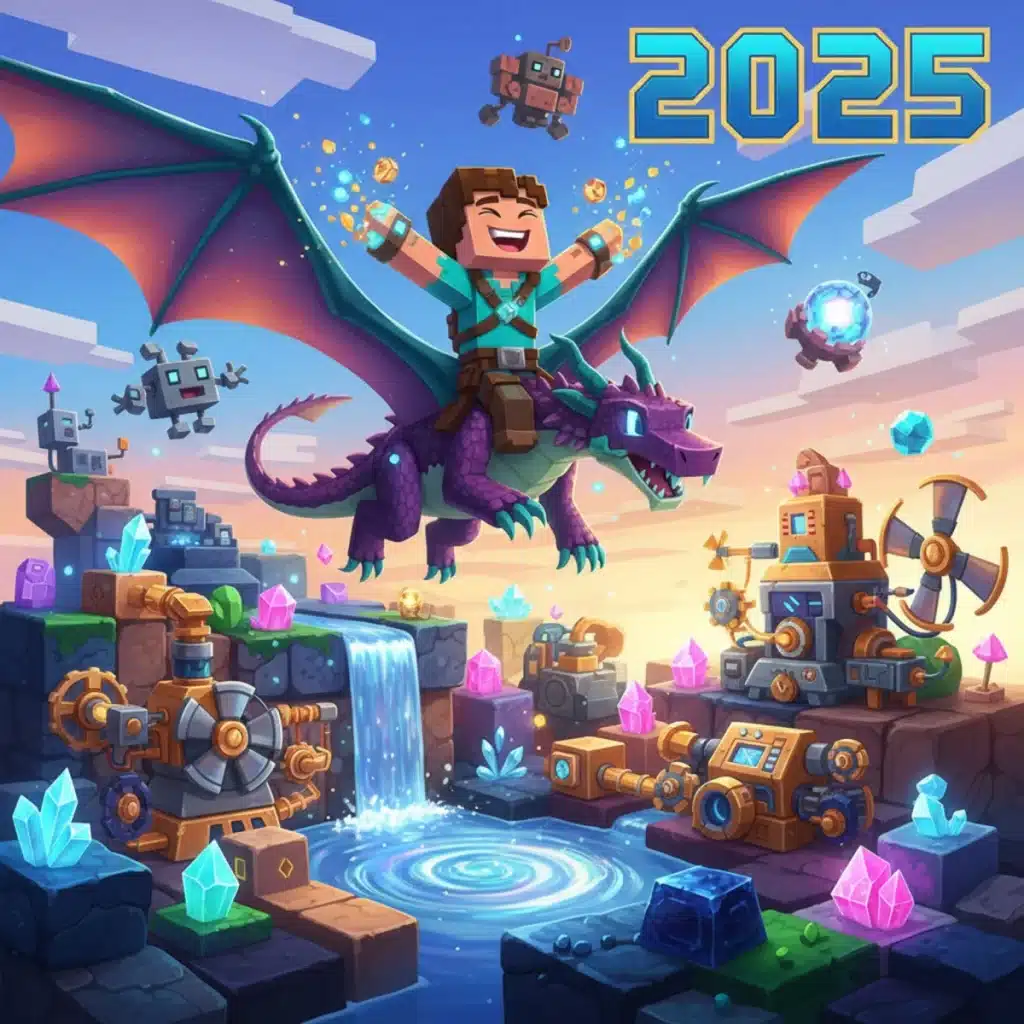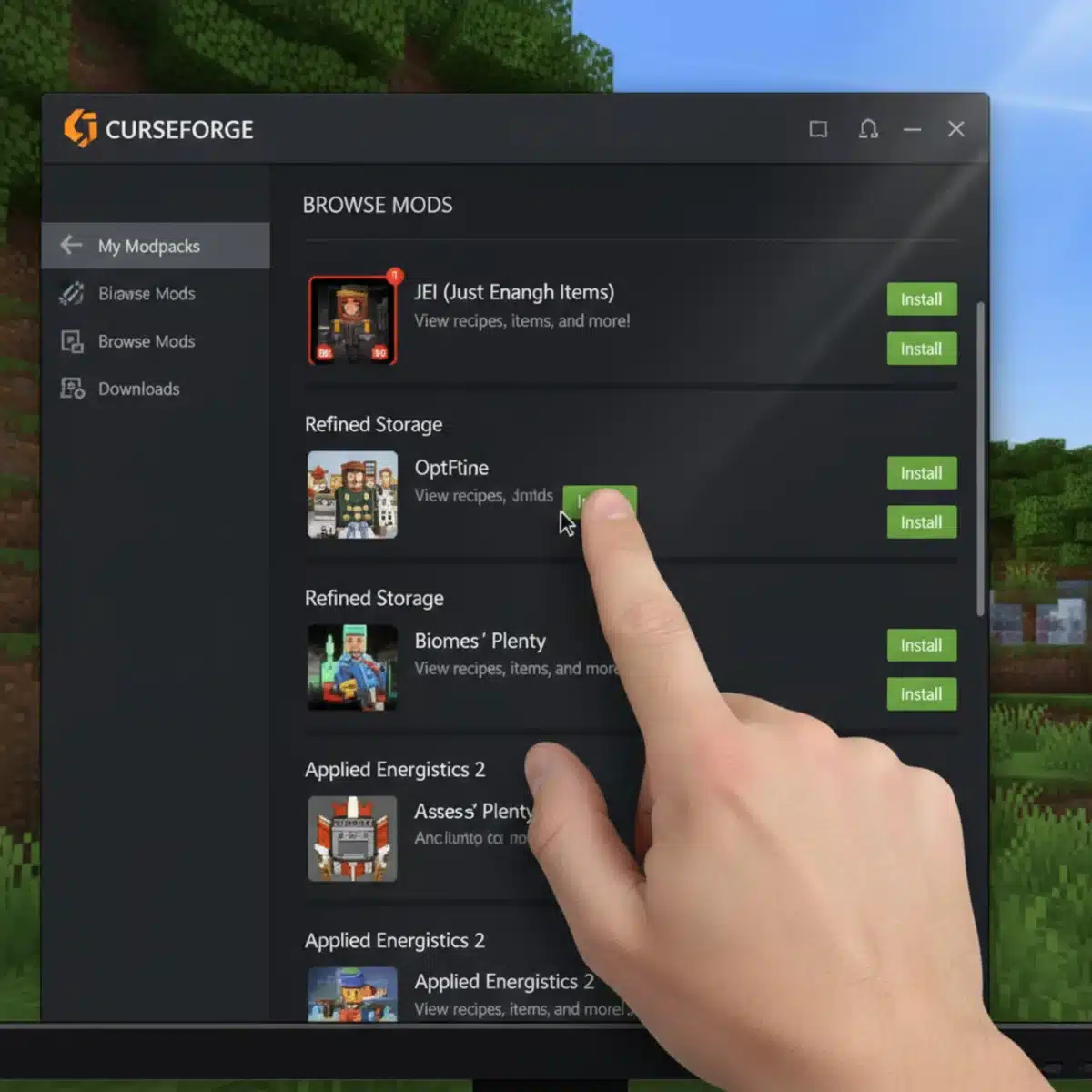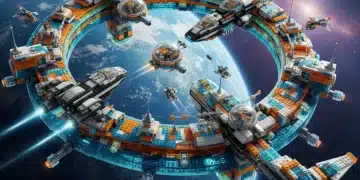Minecraft Modding 101: A Beginner’s Guide for 2025

Advertisements
This guide provides a comprehensive introduction to Minecraft modding for beginners in 2025, detailing installation, management, and essential safety tips to enhance your gameplay experience.
Are you ready to transform your Minecraft world into something truly extraordinary? Diving into Minecraft Modding 101: A Beginner’s Guide for 2025 opens up a universe of new adventures, tools, and visual enhancements that the vanilla game simply can’t offer. Whether you dream of flying dragons, building complex machinery, or exploring alien dimensions, mods are your ticket to an infinitely customizable experience.
Anúncios
Understanding the basics of Minecraft modding
Modding in Minecraft refers to the act of modifying the game’s code or adding custom content created by other players. These modifications, known as ‘mods,’ can range from minor tweaks, like adding new types of blocks or items, to complete overhauls that introduce new game mechanics, dimensions, and creatures. For beginners in 2025, understanding what mods are and how they interact with your game is the first crucial step towards customizing your Minecraft experience.
At its core, a mod is a piece of software that alters the original game. This means that mods are not officially supported by Mojang, the creators of Minecraft, but are instead community-driven additions. The vast ecosystem of Minecraft mods thrives on the creativity and dedication of players worldwide, constantly pushing the boundaries of what’s possible within the blocky universe. Learning the basics involves recognizing the different types of mods and their general functions.
Anúncios
Types of Minecraft mods
The world of Minecraft mods is incredibly diverse, offering something for every type of player. From aesthetic changes to significant gameplay alterations, knowing the categories can help you navigate the options.
- Content mods: These add new items, blocks, mobs, or even entire dimensions. Examples include mods that introduce magic systems or advanced technology.
- Utility mods: Focused on improving gameplay convenience, such as mini-maps, inventory management tools, or performance enhancers.
- Visual mods: These mods enhance the game’s graphics, including shaders for realistic lighting and shadows, or texture packs for higher resolution visuals.
- Technical mods: Often invisible to the player, these mods provide frameworks or libraries that other mods rely on to function, like Forge or Fabric.
Each type serves a specific purpose, and often, players will combine several different types to create their ultimate personalized Minecraft world. The key is to start small, experiment, and gradually build up your modded experience as you become more comfortable with the process.
In summary, Minecraft modding is about expanding and personalizing your game beyond its original scope. By understanding the fundamental concept of mods and the various categories available, you’ll be well-equipped to begin your journey into a more exciting and customized Minecraft adventure.
Choosing the right mod loader for 2025
Before you can even think about downloading your first mod, you’ll need a mod loader. These essential tools act as a bridge between Minecraft and your chosen mods, allowing them to run smoothly together. In 2025, the two primary mod loaders for Minecraft are Forge and Fabric, each with its own community, mod selection, and installation process.
Selecting the correct mod loader is critical because mods are typically built for one or the other. A mod designed for Forge will not work with Fabric, and vice-versa. Therefore, your choice of mod loader will largely dictate the range of mods available to you. It’s important to research which loader is more suitable for the types of mods you’re interested in.
Forge versus Fabric: Which one is for you?
Both Forge and Fabric have their strengths and weaknesses, making the choice dependent on your specific needs and preferences. Understanding these differences will guide you to the best option.
- Minecraft Forge: Historically, Forge has been the dominant mod loader, boasting a massive library of mods. It’s known for supporting larger, more complex mods that often overhaul significant aspects of the game. Forge tends to be a bit heavier on system resources due to its extensive API.
- Fabric: Fabric emerged as a lighter, more modular alternative. It’s often preferred for newer versions of Minecraft and is known for its speed and efficiency. Fabric’s mod ecosystem has grown rapidly, particularly for performance-enhancing mods and those that aim for more subtle game alterations.
For beginners, if you’re looking to play with a wide variety of established, content-rich mods, Forge might be your go-to. If you prioritize performance, want to play on the absolute latest Minecraft versions quickly, or prefer smaller, more focused mods, Fabric could be a better fit. Many players even maintain separate Minecraft installations for both loaders to enjoy the best of both worlds.
Making an informed decision about your mod loader is a foundational step in your modding journey. Consider the types of mods you wish to use and the Minecraft version you plan to play, as these factors will heavily influence which loader provides the best experience for you in 2025.
Step-by-step mod installation process
Once you’ve chosen your mod loader, the actual installation of mods becomes a straightforward process. While specific steps might vary slightly between Forge and Fabric, the general principle remains the same: download the mod, place it in the correct folder, and launch the game. This section will walk you through the universal steps to get your first mods running.
Before you begin, always ensure that your Minecraft game client is updated to the version compatible with your chosen mod loader and the mods you intend to install. Version mismatches are the most common cause of modding issues. Also, it’s a good practice to back up your Minecraft saves before introducing new mods, just in case something goes wrong.
Installing your chosen mod loader
The first step is to install either Forge or Fabric. Both have dedicated websites where you can download their installers.
- Download the installer: Visit the official Forge or Fabric website and download the installer for your desired Minecraft version.
- Run the installer: Execute the downloaded .jar file. This will typically open a small window where you can select ‘Install Client’ and then click ‘OK’. The installer will automatically set up the necessary files in your Minecraft directory.
- Verify installation: Open the Minecraft Launcher. You should now see a new profile option (e.g., ‘forge-1.X.X’ or ‘fabric-loader-1.X.X’) in the bottom-left corner. Select this profile.
After successfully installing the mod loader, you’re ready to add your mods. This part is exciting, as it brings your customized vision to life. Remember to always download mods from reputable sources to minimize risks.

Adding mods to your game
With the mod loader in place, adding individual mods is relatively simple. Most mods are distributed as .jar files.
- Download mods: Find your desired mods from trusted sources like CurseForge. Ensure the mod version matches both your Minecraft version and your mod loader (Forge or Fabric).
- Locate your ‘mods’ folder: In your Minecraft directory, there should now be a folder named ‘mods’. If not, simply create one. You can usually find your Minecraft directory by opening the Minecraft Launcher, going to ‘Installations’, hovering over your modded profile, and clicking the folder icon.
- Place mod files: Drag and drop the downloaded .jar mod files directly into this ‘mods’ folder. Do not extract them unless specifically instructed by the mod developer.
- Launch Minecraft: Start your Minecraft Launcher, select your modded profile (Forge or Fabric), and click ‘Play’. If everything is installed correctly, your mods should now be active in the game.
This process is the backbone of Minecraft modding. By following these steps carefully, you’ll be able to install a wide array of mods and begin exploring the expanded possibilities within your game. Troubleshooting often involves checking version compatibility and ensuring mods are placed in the correct directory.
Essential tools for managing your mods
As your collection of mods grows, managing them efficiently becomes crucial. In 2025, several tools are available to help you keep your modded Minecraft experience organized, stable, and enjoyable. These tools simplify the process of installing, updating, and even creating modpacks, ensuring you spend more time playing and less time troubleshooting.
Manual management of dozens of individual mod files can quickly become cumbersome and prone to errors. Mod managers and launchers are designed to automate many of these tasks, providing a centralized interface for all your modding needs. They are particularly invaluable for beginners who might feel overwhelmed by the sheer volume of available mods and their dependencies.
CurseForge Launcher: Your all-in-one solution
For most beginners, the CurseForge Launcher is the recommended starting point for mod management. It’s a comprehensive platform that integrates mod discovery, installation, and updating into a single, user-friendly application.
- Mod discovery: Browse thousands of mods, filter by game version and mod loader, and read descriptions and reviews directly within the application.
- Easy installation: Install mods with a single click. CurseForge handles dependencies, ensuring all required libraries are also installed.
- Profile management: Create and switch between multiple modded profiles, each with its own set of mods and game version. This is perfect for trying out different modpacks or playing with friends on different servers.
- Updates: Keep your mods updated automatically with built-in update functionality, reducing compatibility issues.
Using a tool like CurseForge significantly lowers the barrier to entry for Minecraft modding. It streamlines the entire process, from finding interesting mods to launching your game with them, making it an indispensable asset for any aspiring modder. Its intuitive interface is designed with ease of use in mind, perfect for those new to the modding scene.
Beyond CurseForge, other launchers like GDLauncher and ATLauncher offer similar functionalities, often with unique features or interfaces. Exploring these options might reveal a manager that better suits your personal workflow. Regardless of your choice, employing a dedicated mod management tool is a game-changer for maintaining a stable and diverse modded Minecraft environment.
Discovering the best mods for 2025
With your mod loader installed and management tools ready, the next exciting step is to explore the vast universe of Minecraft mods. In 2025, the modding community continues to innovate, offering an incredible array of modifications that cater to every playstyle imaginable. Knowing where to look and what to consider will help you find mods that truly enhance your game.
The ‘best’ mods are subjective, depending entirely on what you want to get out of your Minecraft experience. Are you looking for visual upgrades, new challenges, or quality-of-life improvements? Defining your preferences will narrow down the overwhelming number of options and lead you to mods you’ll genuinely enjoy.
Top categories and popular mods to consider
To help you start your search, here are some popular categories and examples of types of mods that are consistently highly rated and widely used:
- Exploration and adventure mods: These mods add new biomes, dimensions, structures, and creatures, making exploration endlessly exciting. Examples include ‘Biomes O’ Plenty’ or ‘The Twilight Forest’.
- Technical and automation mods: For players who love building complex systems, these mods introduce advanced machinery, power generation, and automated farming. ‘Applied Energistics 2’ or ‘Thermal Expansion’ are classic examples.
- Magic mods: Dive into the arcane with mods that add spells, rituals, and magical artifacts. ‘Botania’ and ‘Thaumcraft’ (if updated) offer deep magical systems.
- Quality of life mods: These mods don’t drastically change gameplay but make it more convenient. Think ‘Just Enough Items (JEI)’ for recipes, or ‘Waystones’ for easy teleportation.
- Visual enhancement mods: Beyond texture packs, mods like ‘OptiFine’ (for performance and shaders) and various shader packs (e.g., ‘SEUS’, ‘BSL Shaders’) can transform the game’s appearance.
When selecting mods, always check their compatibility with your Minecraft version and mod loader. Read reviews, watch showcases, and pay attention to any known conflicts with other mods. A thriving modding community means plenty of resources are available to help you make informed decisions.

The journey of discovering new mods is a continuous one. Don’t be afraid to experiment with different combinations and see what works best for your playstyle. The beauty of Minecraft Modding 101: A Beginner’s Guide for 2025 lies in its potential for endless customization and new experiences.
Troubleshooting common modding issues
Even with careful planning and the right tools, encountering issues is a natural part of the modding experience. For beginners in 2025, knowing how to identify and resolve common problems can save a lot of frustration and keep your modded Minecraft world running smoothly. Most issues stem from compatibility problems or incorrect installations.
The key to effective troubleshooting is a systematic approach. Don’t panic when your game crashes or mods don’t appear; instead, take a deep breath and follow a logical series of steps to pinpoint the root cause. This section will cover the most frequent problems and their solutions.
Identifying and resolving conflicts
Mod conflicts are perhaps the most common issue. They occur when two or more mods try to modify the same game element in incompatible ways, leading to crashes or unexpected behavior.
- Check crash reports: When your game crashes, it usually generates a crash report in your Minecraft directory (often in a ‘crash-reports’ folder). These reports contain valuable information, often pointing to the specific mod causing the problem. Look for lines indicating a mod ID or file name.
- Isolate problematic mods: If you suspect a conflict, try removing half of your mods from the ‘mods’ folder and launching the game. If it works, the culprit is in the removed half. If it still crashes, the issue is in the remaining half. Repeat this binary search until you find the conflicting mod.
- Verify versions: Double-check that all your mods, your mod loader, and your Minecraft client are for the exact same game version (e.g., Minecraft 1.20.1, Forge 1.20.1, Mod X 1.20.1). Mismatched versions are a frequent cause of instability.
- Read mod documentation: Many mod developers list known incompatibilities or specific installation instructions on their mod pages. Always consult these resources.
Another common issue is a black screen on startup or infinite loading. This often indicates a severe mod conflict or a missing dependency. Ensure you have installed all required libraries or API mods that your chosen mods might need (e.g., ‘Architectury API’ for some Fabric mods).
Finally, if you’re still stuck, don’t hesitate to reach out to the modding community. Forums, Discord servers, and mod pages often have dedicated sections for support where experienced modders can offer assistance. Providing your crash report and a list of installed mods will greatly help others diagnose your problem. Patience and persistence are your best allies in troubleshooting.
Staying safe and updated in the modding world
While Minecraft modding offers incredible creative freedom, it’s crucial to prioritize safety and stay updated. Downloading mods from untrusted sources can expose your computer to malware, and outdated mods can lead to game instability. In 2025, maintaining a secure and current modded environment is just as important as the mods themselves.
The modding community is generally a safe and welcoming place, but like any online activity, it requires vigilance. Knowing how to identify reputable sources and understanding the importance of regular updates will protect your system and ensure a smooth gaming experience.
Best practices for a secure modding experience
Follow these guidelines to minimize risks and keep your modded Minecraft safe:
- Download from trusted sources only: The most reputable source for Minecraft mods is CurseForge. Other reliable sites exist, but always verify their legitimacy. Avoid downloading mods from random forums or unfamiliar websites.
- Scan downloaded files: Even from trusted sources, it’s good practice to scan any downloaded .jar files with your antivirus software before running them.
- Read comments and reviews: Before downloading a mod, check the comments section and reviews. Users often report issues, bugs, or suspicious behavior, which can be a red flag.
- Back up your saves: Regularly back up your Minecraft save files. This ensures that if a mod corrupts your world, you can revert to a previous, stable state without losing progress.
- Keep your mod loader updated: Ensure your Forge or Fabric loader is always up to date. Updates often include bug fixes and security patches.
- Update mods cautiously: While keeping mods updated is good, always check for compatibility with your current Minecraft version and other installed mods before updating. Sometimes, newer versions of a mod might introduce new bugs or conflicts.
Staying informed about the modding community’s best practices is an ongoing process. Pay attention to warnings from mod developers and community leaders. By being proactive and selective about what you install and from where, you can enjoy the vast benefits of Minecraft modding without compromising your digital safety. A little caution goes a long way in ensuring a fun and secure modded adventure.
| Key Aspect | Brief Description |
|---|---|
| Mod Loaders | Essential tools (Forge, Fabric) to run mods; choose based on desired mods & game version. |
| Installation | Download .jar files, place in ‘mods’ folder; ensure version compatibility. |
| Mod Management | Use launchers like CurseForge for easy discovery, installation, and updates of mods. |
| Safety Tips | Download from trusted sources, back up saves, and scan files to avoid malware. |
Frequently asked questions about Minecraft modding
Forge is known for its extensive mod library and support for larger, more complex mods, often with greater system resource usage. Fabric is a lighter, more modular alternative, favored for performance and quicker updates to newer Minecraft versions, attracting a growing number of specialized mods.
No, mods are specifically developed for either Forge or Fabric and are not cross-compatible. Attempting to mix them will lead to crashes and errors. It’s recommended to maintain separate Minecraft installations or profiles for each mod loader.
The safest and most recommended platform for downloading Minecraft mods is CurseForge. It’s a well-moderated repository that scans files for malicious content, ensuring a safer modding experience. Always prioritize official mod pages on trusted sites.
First, check the crash report for clues about the problematic mod. Then, try removing the newly installed mod to see if the game launches. Ensure all mods and your mod loader are compatible with your specific Minecraft version. Isolate mods using a binary search method if necessary.
Yes, backing up your Minecraft worlds is highly recommended before installing or updating mods. Mods can sometimes corrupt save files or cause unexpected issues. A backup ensures that you can always revert to a stable version of your world if something goes wrong during the modding process.
Conclusion
Embarking on the journey of Minecraft modding in 2025 promises an unparalleled level of customization and extended gameplay. By understanding the fundamentals, selecting the right mod loader, and diligently managing your installations, you can transform your blocky world into an endless canvas for creativity and adventure. Remember to prioritize safety by downloading from trusted sources and regularly backing up your saves. The world of modded Minecraft is vast and ever-evolving, offering something new for every player, from simple quality-of-life enhancements to complete game overhauls. Dive in, experiment, and discover the limitless possibilities that await you!





